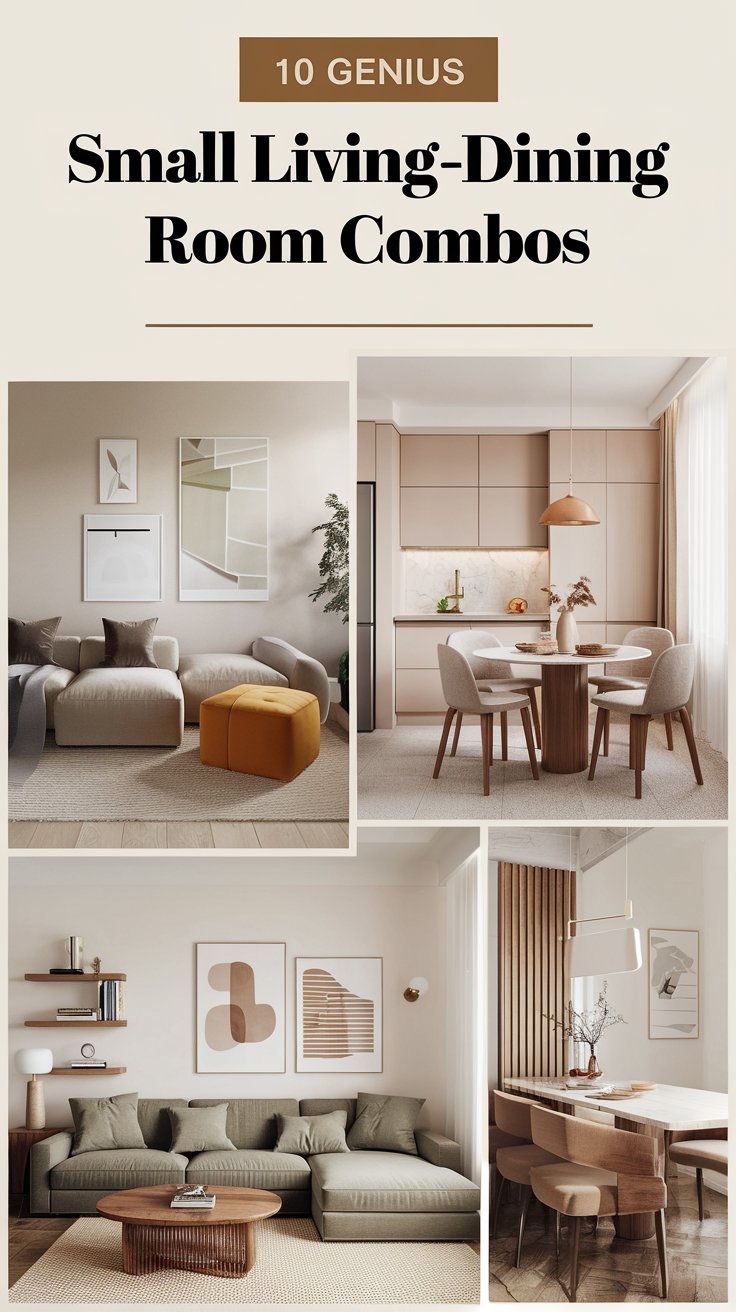When you’re living in a small space, every square foot matters. But who says you have to sacrifice style for functionality? Combining your living and dining areas isn’t just practical—it’s an opportunity to create a cozy, stylish, and personalized space that serves double duty. Whether you’re decorating your first apartment, downsizing to a more minimalist lifestyle, or just want to maximize your space, a well-planned living/dining combo can be a total game-changer.
This blog is your go-to guide for transforming even the tiniest open-concept or studio layout into a beautifully balanced living and dining area. From layout hacks and space-saving furniture to clever decor tips, I’ll walk you through 10 genius ideas that make your space work harder—while looking like something straight off your Pinterest board.
So grab your favorite throw blanket and a cup of coffee—let’s dive into the most practical, gorgeous, and oh-so-doable combos you can start working on today.
1. The “Zoned and Cozy” Layout

Small spaces thrive on organization, and zoning is the secret weapon that makes a combo living/dining room feel intentional—not cramped. Think of zoning as creating “invisible boundaries” within one open room, which helps each space feel defined and functional without needing walls. With the right layout, your dining nook and living area will flow together beautifully without getting in each other’s way.
The key is all in the arrangement. You’ll use rugs, lighting, and strategic furniture placement to carve out distinct areas while still keeping a cohesive style. Don’t worry—you don’t need to be a professional designer to pull this off. Once you learn the trick, it’s surprisingly simple to execute.
Whether you’re hosting a cozy dinner or binge-watching your favorite show, zoning helps you feel like you’re in the right spot for every activity—without sacrificing style or space.
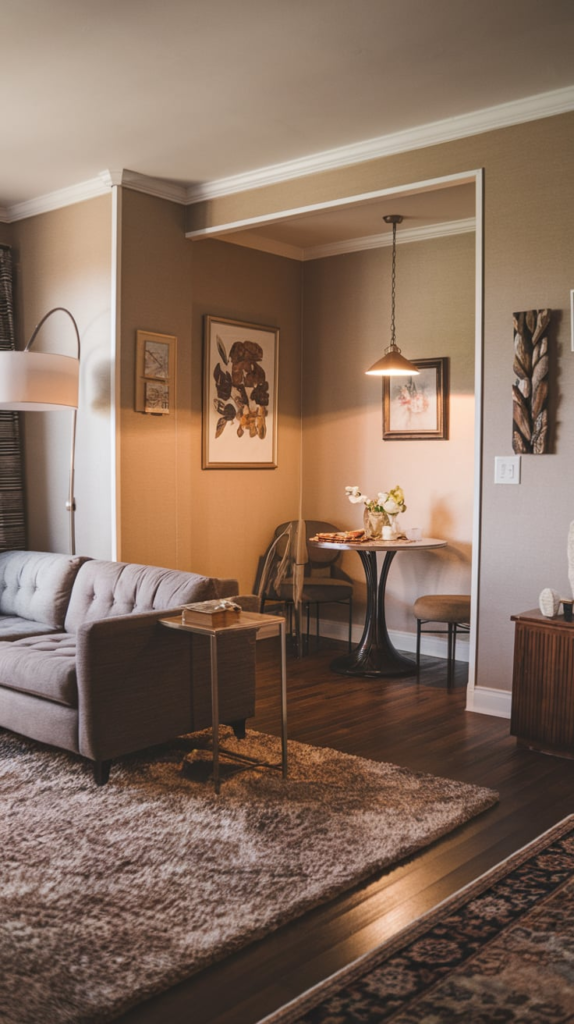
Step by Step:
- Lay down two separate area rugs—one under your living space and one under your dining table. This instantly divides the zones.
- Use a sofa as a divider. Place the back of your couch facing the dining area to create a soft boundary.
- Add lighting to match each zone. Use a floor lamp in the living area and a pendant light or chandelier over your dining table.
- Coordinate colors and textures. Use similar hues in both zones to keep things feeling connected.
Imagine This:
Picture stepping into a chic, cozy room where the plush rug and comfy couch invite you to unwind, while just a few feet away, a stylish bistro table under a warm pendant light says, “Let’s have dinner.” Everything flows, but each zone feels like its own cozy world.
2. The “Double-Duty Furniture” Magic
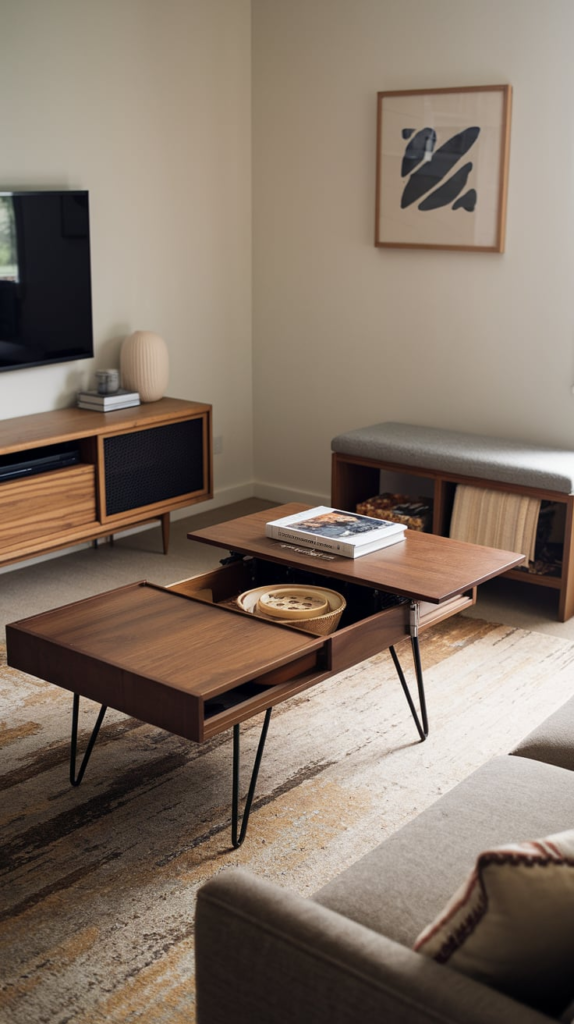
When every piece of furniture counts, versatility is the name of the game. This approach is all about finding pieces that serve more than one purpose—think coffee tables that expand into dining tables, or benches that offer storage and seating. It’s the ultimate small-space hack: style meets function in the most satisfying way.
Instead of stuffing your space with too many pieces, double-duty furniture keeps your room feeling airy and open. These smart choices save floor space and money, and they look intentional and sleek—like your home came straight out of a design magazine.
You’ll be surprised how easy it is to find or DIY multi-functional pieces. And once you do, your home won’t just look amazing—it’ll work for your lifestyle in all the right ways.

Step by Step:
- Invest in a convertible dining table. Look for drop-leaf or expandable models.
- Use a bench with storage. Place it by your dining table for seating, and stash throw blankets or board games inside.
- Swap your coffee table. Choose one that lifts up into a workspace or dining surface.
- Opt for a slim sideboard. It can hold dining essentials and also serve as a TV console or display shelf.
Imagine This:
Imagine hosting a casual wine night. You lift your chic coffee table into dining mode, pull out two cozy ottomans, and just like that, you’re dining in style. Afterward, everything tucks back neatly, and your living room is back—like magic.
3. The “Color Cohesion” Trick
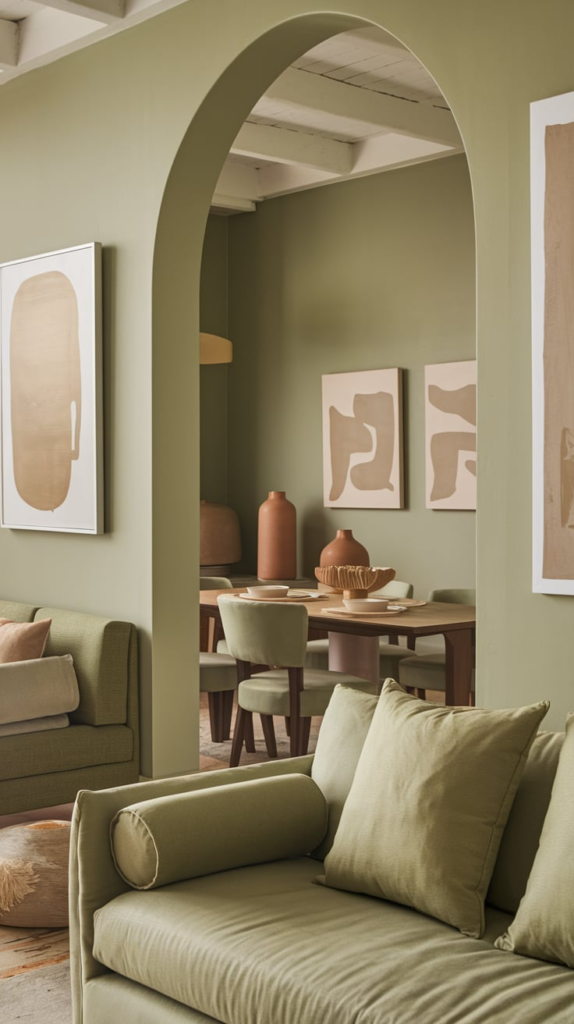
Color can do wonders in a small space—it can define zones, create visual flow, and make everything feel more expansive. A cohesive color palette is a must when blending living and dining areas. It doesn’t mean everything has to match exactly; it’s about creating harmony and balance through complementary tones.
Think of your space like an outfit: your living and dining areas are separate pieces, but they need to go together. Choose a base color, a few accents, and maybe one bold pop to keep things visually interesting without overwhelming the eye.
This technique is especially helpful in open-concept spaces or studio apartments where walls don’t provide separation. With a unified color scheme, your home feels stylish and thoughtfully designed—no matter how small it is.
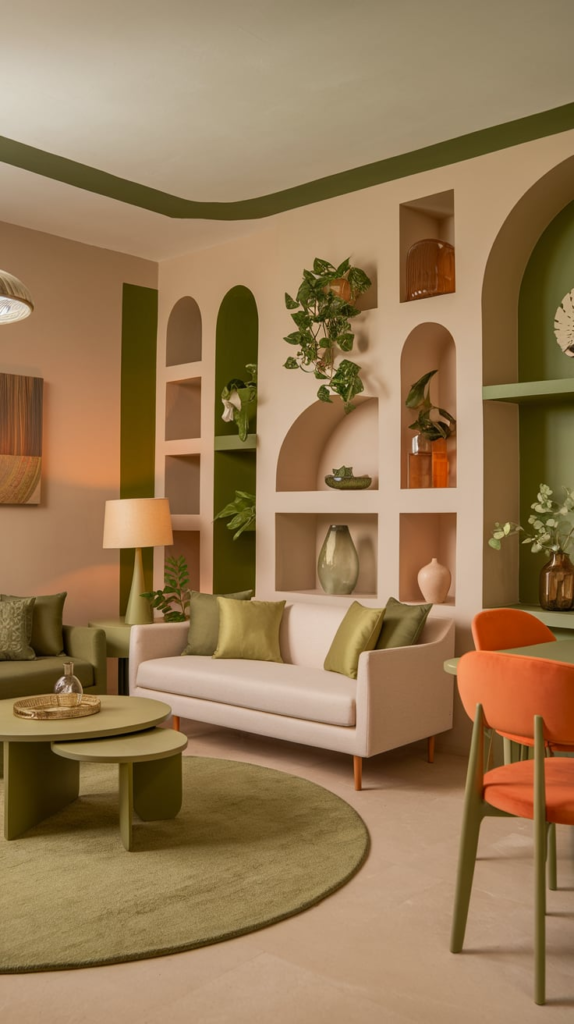
Step by Step:
- Pick a base color. Choose a neutral like white, gray, beige, or soft green.
- Select 2-3 accent colors. Use these across both areas in pillows, art, rugs, and accessories.
- Repeat colors with intention. Have at least one element in each zone that uses each color (e.g., blue cushions on the couch and blue napkins on the table).
- Add a pop color sparingly. A bold vase or art piece in a vibrant hue can tie it all together.
Imagine This:
You walk into your apartment, and it just feels right. Soft sage green ties the throw pillows, artwork, and tabletop decor together. There’s a sense of calm and cohesion—like your space is giving you a warm hug.
4. The “Bench Built-In” Look

Benches aren’t just for entryways. In a small combo space, a bench can anchor your dining area without making it feel cluttered. A built-in or freestanding bench against a wall saves space, offers extra seating, and gives you a chance to add cozy textures with pillows and throws.
Benches are brilliant for awkward corners or narrow spaces that don’t fit traditional chairs. Plus, they let you push your table closer to the wall—making your space feel instantly bigger. Add storage underneath, and it’s a trifecta of style, seating, and smart organization.
Whether you buy one or build one, benches bring a casual, café-like charm to your home that makes every meal feel extra special.
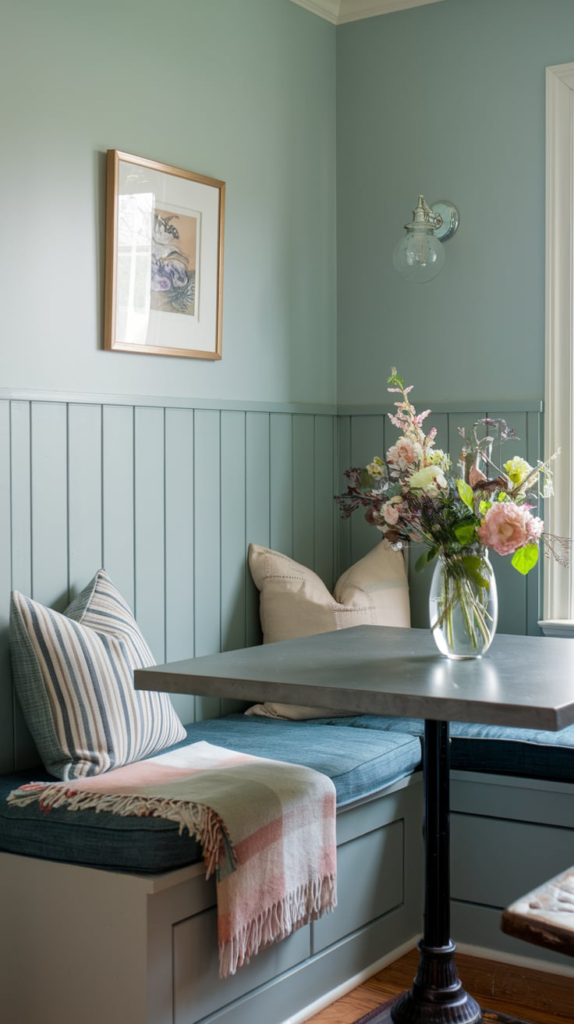
Step by Step:
- Choose your location. Place your bench against the longest wall near your living area.
- Pair it with a small table. Round tables work great for tighter spaces.
- Add soft textiles. Layer with seat cushions, throws, and pillows for comfort.
- Use storage bins or baskets. Slide them under the bench to store linens or seasonal decor.
Imagine This:
Your morning starts with coffee on a cushioned bench bathed in sunlight, surrounded by pillows and soft textures. It’s your personal café corner, right inside your living room.
5. The “Furniture on Wheels” Flex
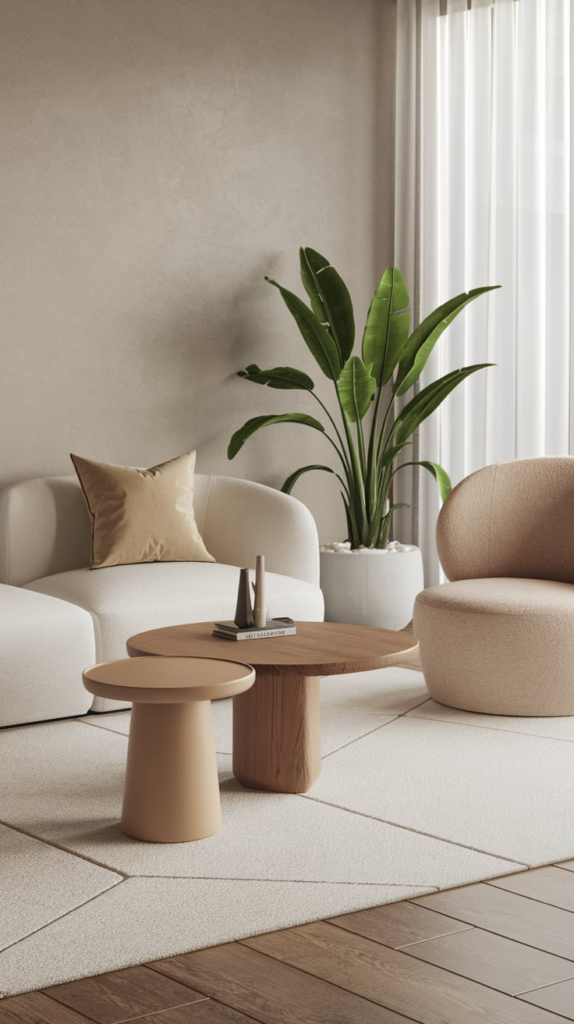
When space is tight, flexibility is everything. Furniture on wheels lets you shift your layout as needed—whether you’re entertaining friends or doing a solo yoga flow. It adds movement, energy, and a touch of creativity to your space.
Rolling furniture is especially helpful for dining tables, bar carts, or storage units. You can tuck them away when not in use or roll them out when guests arrive. This kind of adaptability keeps your space working with you, not against you.
It’s a playful, practical way to keep things fresh and functional—plus, it’s just fun to change up your space on a whim.
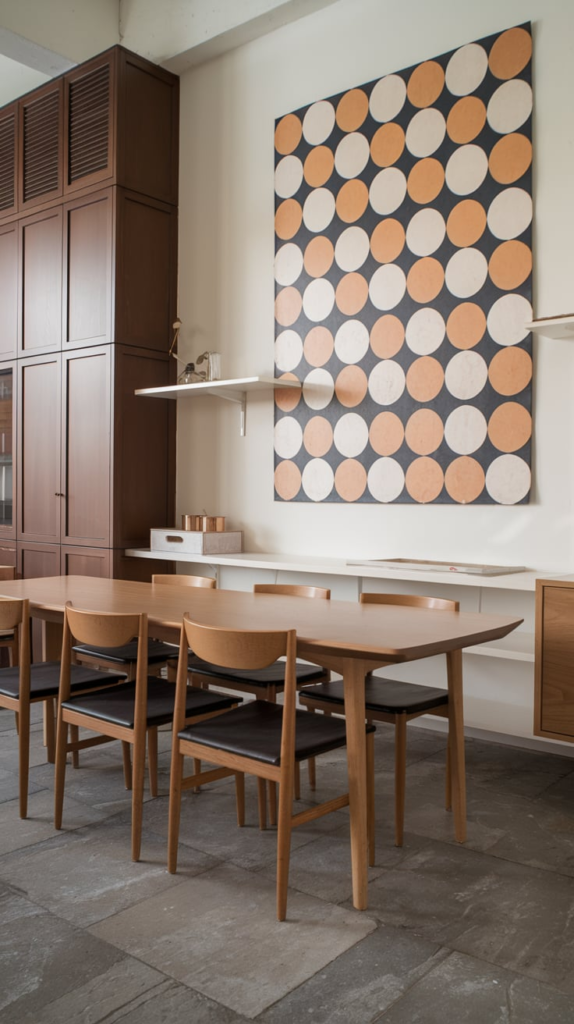
Step by Step:
- Choose mobile pieces. Look for rolling dining tables, storage carts, or ottomans.
- Keep wheels soft and silent. Rubberized wheels are best for hardwood floors and rugs.
- Use locking casters. Make sure pieces can be secured in place when needed.
- Style your mobile pieces. Decorate bar carts or tables so they look great even when not in use.
Imagine This:
You’re prepping for a dinner party. You roll out your sleek cart loaded with wine and appetizers, wheel the dining table forward, and in minutes your tiny space becomes the perfect hosting zone.
6. The “Mirror Magic” Illusion
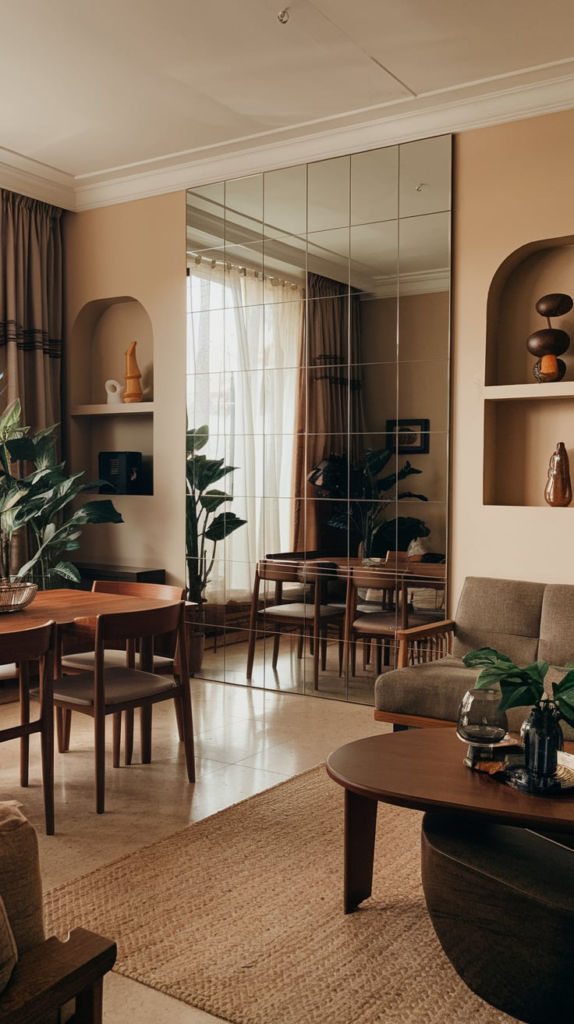
In a small space, mirrors are like cheat codes. They bounce light around, create the illusion of depth, and make rooms feel double their size. When you’re combining a living and dining area, strategically placed mirrors can make the space feel expansive, bright, and oh-so-glamorous.
Mirrors aren’t just functional—they’re a style statement. Whether you go for a vintage gold-framed mirror above your dining table or a sleek floor-length mirror behind your sofa, they can reflect beautiful elements of your room, making everything feel more intentional and elevated.
This trick works especially well in spaces with limited natural light. Mirrors placed opposite windows or light fixtures amplify brightness, making your combo room feel light, airy, and luxurious.
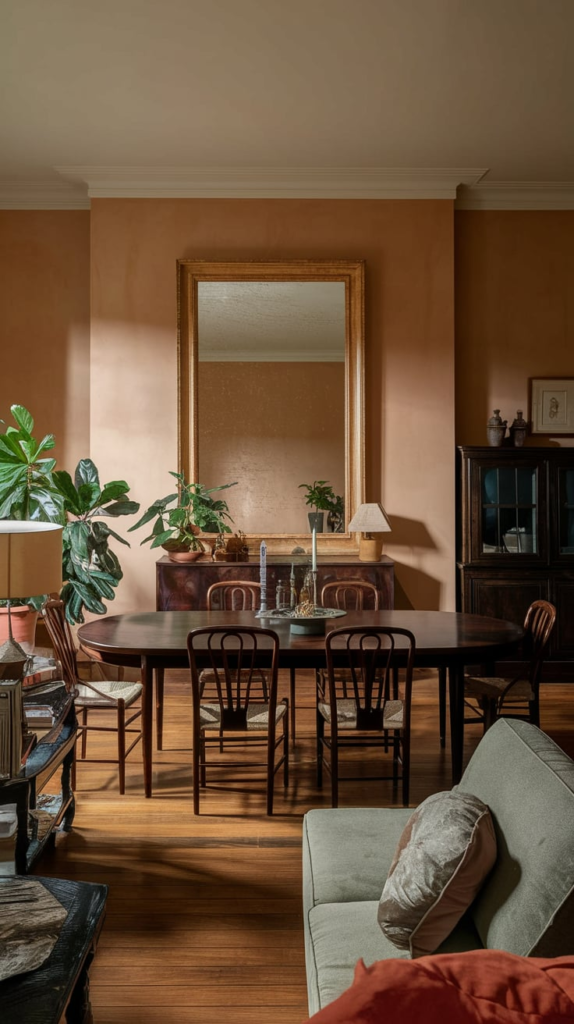
Step by Step:
- Identify your darkest wall or corner. This is where your mirror will have the biggest impact.
- Hang a large mirror or lean a floor mirror. Position it where it reflects light or an eye-catching element.
- Add lighting nearby. A mirror near a lamp or chandelier doubles the glow.
- Consider mirrored furniture. Sideboards or coffee tables with mirrored surfaces add a subtle shine.
Imagine This:
You sit down to dinner and glance over at your reflection—your cozy dining nook glows from a nearby pendant light, its sparkle bouncing beautifully in the mirror behind you. The whole room feels bigger, brighter, and just a little more magical.
7. The “Vertical Vibe” Strategy
When floor space is limited, look up! Vertical storage and decor draw the eye upward, making your living/dining combo feel taller and more open. Think wall-mounted shelves, tall bookcases, and hanging planters—anything that uses wall height to your advantage.
Not only does this maximize storage without cluttering your floor, but it also gives your space a designer feel. Layered vertical elements add depth and character, especially when you mix decor, books, and greenery.
Best of all, this strategy helps separate zones visually. A tall shelf between your couch and dining area becomes a soft divider, while still allowing light and openness to flow through.
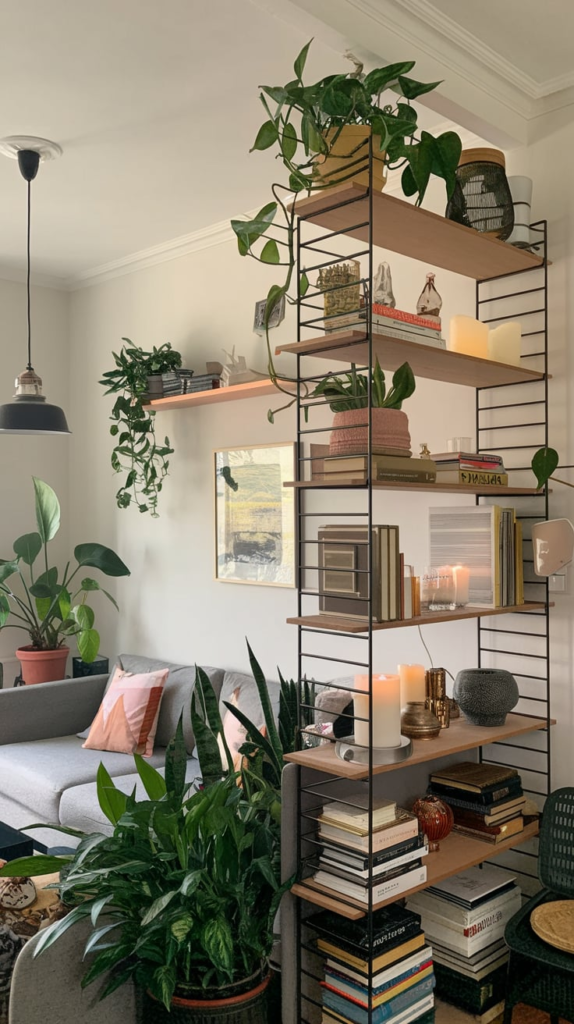
Step by Step:
- Add tall shelving units. Place them near the junction between your dining and living spaces.
- Mount floating shelves. Use them above your sofa and dining table for art or functional decor.
- Hang plants or pendant lights. These vertical accents draw the eye up and add style.
- Avoid overcrowding. Leave negative space on shelves for a clean, airy look.
Imagine This:
Your small space suddenly feels sky-high. A tall shelf filled with plants, books, and candles cozily separates your sofa from your dining nook, while pendant lights above the table make the whole room feel curated and calm.
8. The “Glass and Light” Combo
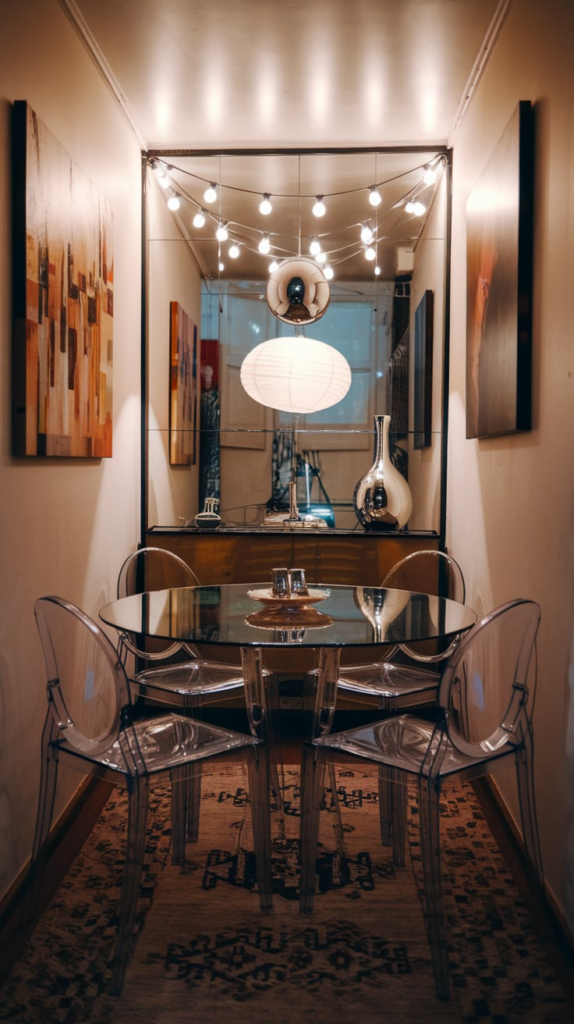
Nothing opens up a small room like glass. Transparent materials, from glass dining tables to acrylic chairs, help maintain visual flow and prevent your space from feeling chopped up or cramped. Combine that with thoughtful lighting, and you’ve got a layout that feels modern, airy, and refined.
This combo is all about optical illusion. When you can see through your furniture, your eye travels farther, making the room feel more spacious. Add soft, ambient lighting and a few reflective accents, and suddenly your space feels like a boutique hotel suite.
It’s a sleek and stylish approach that works well in urban apartments or anyone craving a light, minimalist aesthetic.
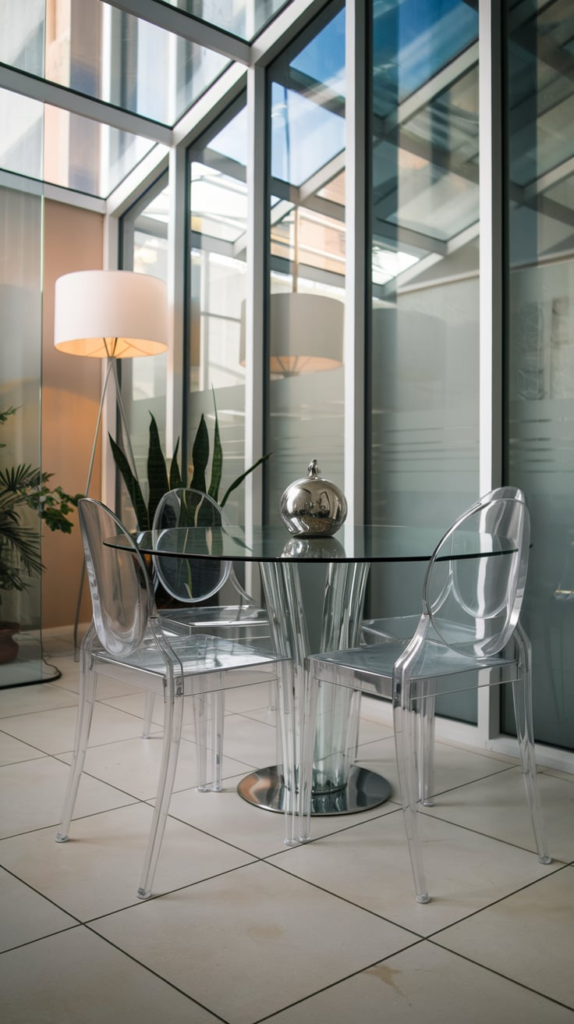
Step by Step:
- Choose a glass or acrylic dining table. It blends effortlessly into the room.
- Use transparent or light-framed chairs. Ghost chairs or slim metal chairs work beautifully.
- Add layered lighting. Use a mix of table lamps, floor lamps, and string lights for warmth.
- Keep surfaces clear. Let light bounce freely around your room.
Imagine This:
You’re sipping wine at your glass-top dining table as warm fairy lights twinkle above. The clear chairs and reflective accents make the room glow, feeling open, elegant, and serene.
9. The “Symmetry Balancer”
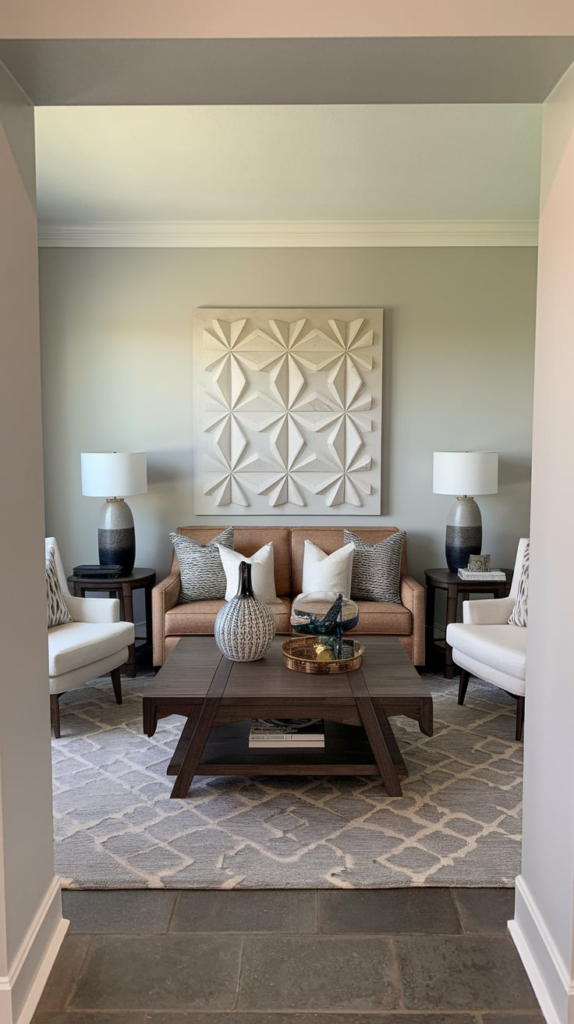
Symmetry creates harmony—and in a small living/dining combo, it can bring a sense of calm and balance that makes your space feel intentional and spacious. This layout trick involves creating visual pairs: matching lamps, chairs, or art that center around a focal point.
When things are balanced, your eye relaxes. The room feels more open because there’s no visual chaos. This approach is perfect for long, narrow spaces or open-concept rooms where you need a little visual order.
Symmetry doesn’t mean boring! You can still play with color, texture, and fun shapes—it’s all about alignment and repetition that subtly guide the flow of your space.
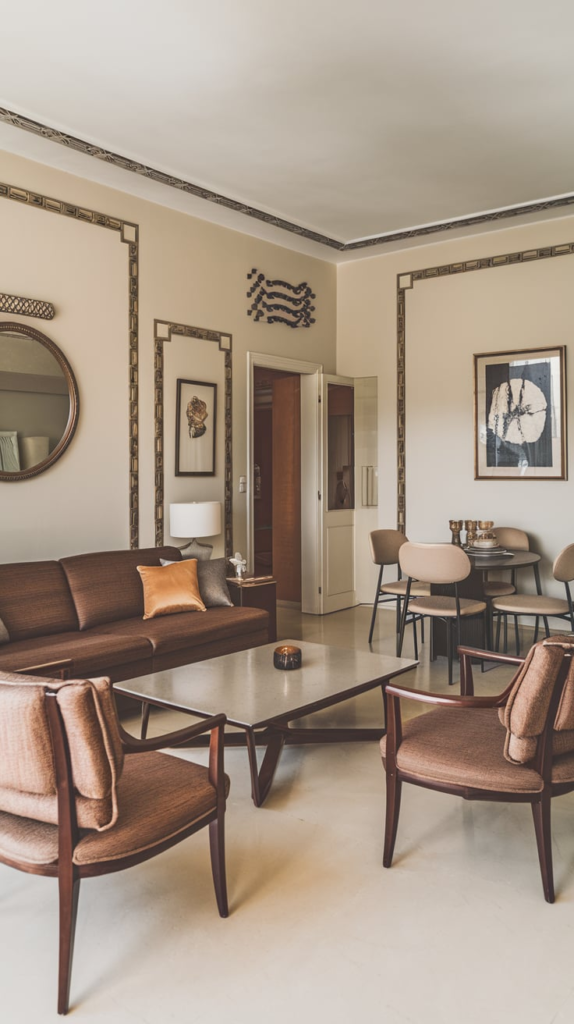
Step by Step:
- Identify a focal point. This could be your coffee table, a wall of art, or a rug.
- Build out matching elements. Place two matching chairs, lights, or decor pieces on either side.
- Use mirrors or wall art for balance. Symmetrical arrangements above the sofa or dining area work wonders.
- Keep furniture aligned. Arrange your sofa and table so they mirror each other across the room.
Imagine This:
Your living and dining areas mirror each other like a perfect little oasis. Matching chairs flank your round dining table while twin lamps glow on either side of the sofa. The whole space feels thoughtful, balanced, and beautiful.
10. The “One Bold Piece” Statement
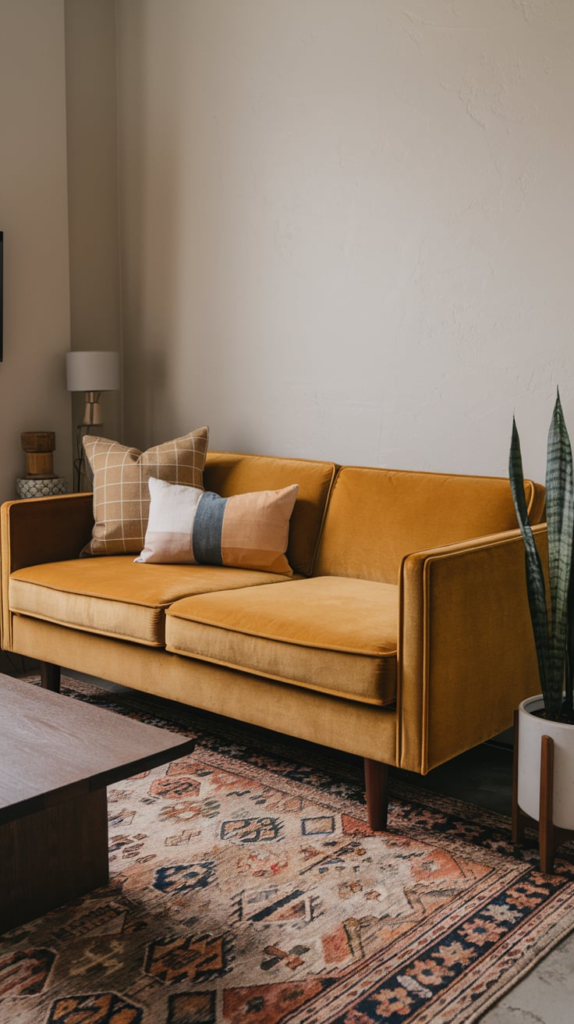
When space is limited, less is more—but that doesn’t mean you can’t go bold. One statement piece—a dramatic art print, colorful sofa, oversized light fixture, or patterned rug—can anchor your space and elevate your entire combo layout.
This method is all about confidence. Choose one standout feature and build your design around it. Everything else should support that piece, letting it shine without competing. It gives your small space a strong identity and a splash of personality.
This trick works especially well for Pinterest lovers who want a chic, editorial look without overcrowding their space. Let your personality pop!
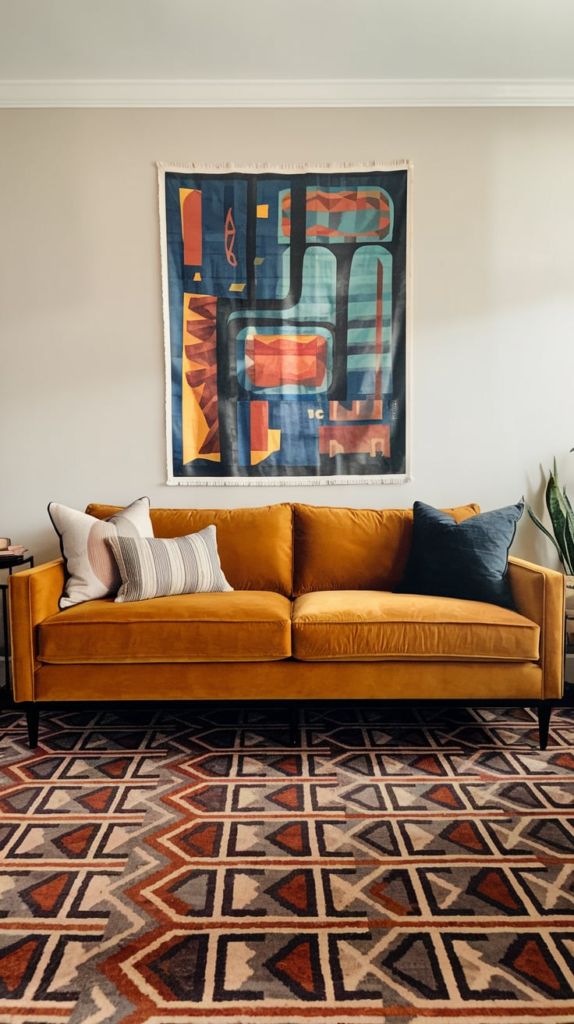
Step by Step:
- Pick your hero piece. Choose a bold rug, colorful couch, or giant piece of art.
- Keep the rest simple. Neutral tones and clean lines help your statement piece stand out.
- Echo its colors or shape. Use accessories that reference the bold element subtly.
- Let it breathe. Give it enough space so it feels intentional, not cramped.
Imagine This:
Your mustard velvet sofa sits boldly in the middle of your space, the star of the show. The rest of the room leans into soft creams and golds, letting that one piece sing. It’s daring, it’s dreamy—and it’s so you.
Final Thoughts: Style Meets Strategy
There you have it—10 genius ways to combine your living and dining room in a small space without sacrificing style, comfort, or functionality. These tricks aren’t just design fluff—they’re practical, powerful tools to help you fall in love with your home every single day.
Whether you’re renting, renovating, or just rearranging, remember: your space should serve you. Let these ideas inspire you to get creative, try something new, and make the most of every square inch. You’ve got this—and your dream layout is totally within reach.
